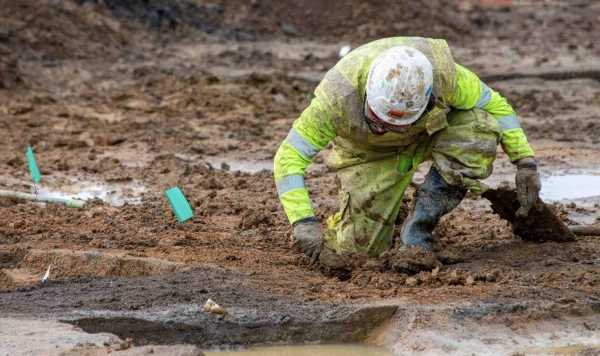
Iron Age Britain: Cannibalism evidence discussed by expert
We use your sign-up to provide content in ways you’ve consented to and to improve our understanding of you. This may include adverts from us and 3rd parties based on our understanding. You can unsubscribe at any time. More info
Archaeologists have made a spectacular discovery after unearthing evidence of a 2,000y ear-old feast from the Iron Age while excavating the site of a road improvement scheme. When experts were digging at the site of the proposed work on the A428 between the so-called Black Cat roundabout in Bedfordshire and Caxton Gibbet in Cambridgeshire, they may not have expected to come across anything mind-blowing.
But during the dig, the team from the Museum of London Archaeology (MOLA) was lucky enough to stumble across a pit full of animal bones, pottery and burnt stones.
Ancient pottery and animal bones reportedly indicate the location was likely a communal area for feasts. the finds could reveal imported insights into changes in diet and gifting during the time period.
The researchers also suspect that they found evidence of a large fire that Iron Age communities would likely have gathered around for big feasts between the years 800BC and AD43.
Experts are now set to analyse the bones, pottery, and other evidence, including burnt grains. This will help to more accurately pinpoint the time period and gain further insights into the Iron Age feast.


Gary Brogan, MOLA Project Director said: “The A428 excavations are an amazing opportunity, we are getting to see the big picture of life in the past across the region.
“Uncovering an Iron Age feast and possible evidence for beer brewing in the early Roman period, is transforming our understanding of the past communities of Bedfordshire and Cambridgeshire, from what they were eating and drinking, to how they may have traded both locally and across the Roman Empire.”
Lorraine Bennetts, senior project manager at National Highways, said: “It’s been wonderful to see how the A428 improvements are revealing the stories of the people living in Bedfordshire and Cambridgeshire thousands of year ago, which we hope will inspire and intrigue local residents in the present day,” she said.
“The uncovering of this Iron Age feast is just the beginning, and we look forward to sharing more information as the dig progresses.”

A MOLA spokesperson said: “As large quantities of grains are only allowed to germinate when the aim is to produce malt – the first step in the brewing process – this strongly suggests the people living at the settlement were involved in beer production.”
But Project science advisor Rachel Ballantyne said that beer was not necessarily made at this exact spot. She said: “It is possible only malt was being produced here, which was then taken to be brewed elsewhere.
“This raises interesting questions about how the people living in this farm might have been interacting with neighbouring communities as part of a wider trade network.”The germinated grains are likely to have been accidently burnt, but this ancient mistake has benefitted our research.”


Experts have also found Neolithic and Bronze Age flint arrowheads at the site, dating to between 4000 to 700BC. This discovery suggested that people were hunting animals in the area well in advance of the farmstead.
They also found two 15m (49ft) round houses, providing evidence of a settlement at the site, while the remains of butchered animals, pottery, loom weights for weaving and personal items were also discovered.
Lead archaeologist Dr Steve Sherlock said: “What is particularly exciting is the site was initially established beside a substantial boundary ditch and we think this boundary was used to define perhaps a tribal area.
“This large ditch seems to have been maintained and occasionally redefined, whilst Iron Age settlements here and elsewhere respect the feature.”
Source: Read Full Article